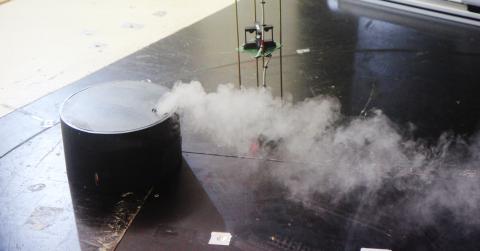ICASSP 2025 SP Grand Challenge: Gas source localization from real-world spatial in-situ concentration and wind measurements.
- Submission Dates:
- 08/04/2024 to 04/30/2025
- Citation Author(s):
- Submitted by:
- Dmitriy Shutin
- Last updated:
- Thu, 11/28/2024 - 06:35
- DOI:
- 10.21227/x0sf-ad36
- Data Format:
- License:
- Creative Commons Attribution
 1966 Views
1966 Views- Categories:
- Keywords:
Abstract
The scope of this challenge is development of signal processing methods for localizing a gas source using in-situ wind speed and gas concentrations measurements. The methods are designed to advance robotic olfaction and associated autonomous robotic exploration techniques -- highly relevant yet challenging problems in the context of gas source localization, environmental monitoring, and civil security, to name only a few.
Development of the corresponding techniques, however, requires experimental data to benchmark different methodologies and get better understanding of the observed phenomena. Yet accurate, realistic gas observations with robotic platforms remain challenging due to a number of factors, such as variability of the environment (e.g., temperature, wind, or propagation geometry), sensor limitations, and as well as interference from various sources. As a consequence, advanced data analysis and careful experimental designs are essential to address these challenges and achieve reliable gas observations. To address these issues, data have been collected under controlled conditions in the Low-Speed Wind Tunnel (LST), Marknese, Netherlands. The wind tunnel setting allows studying gas propagation under stable wind conditions, thus providing quasi-stationary measurements. By using a synthetic gas source, realized with a commercial fog machine with custom fog fluid, along with a specially constructed sampling device, a high resolution sampling and sensor characterization can be realized. For gas sensing, commercially available and compact sensors like MOX (metal oxide) and PID (photo-ionization) are used; in addition, anemometers are employed to measure wind at the sampling locations. In this way a comprehensive, accurately localized ground truth gas observations are collected.
The goal of this challenge is to utilize the collected data to benchmark and advance corresponding signal processing methods for gas sensing and olfaction. Specifically, using the collected data, the participants are tasked with solving the following Gas Source Localization (GSL) problem:
Given samples of measured gas concentration values and wind at different spatial locations of the exploration area,
- determine the location of the gas source, and
- provide the corresponding uncertainty estimate, thus quantifying localization precision.
The data set provides sufficient material for developing and testing signal processing tools. Several measurement settings are used: one for training, and one for validation of the developed methods. We expect successful contributions to enhance existing data-driven or model-based techniques, or propose original, novel solutions to this GSL challenge. The proposed methods should be efficient, since robotic measurements are often ``expensive''. This implies that the designed solutions should utilize as few measurements as possible to achieve a precise and accurate source localization. The achieved accuracy and precision of GSL solution versus the number of required samples will thus be utilized as key metric to compare different algorithms.
To participate in the challenge, you need to register yourself or your team. To do that you can either send an email to challenge2025.gsl@gmail.com and request a registration providing the following information:
1. First and Last Name,
2. Contact email,
3. Organization/Institution name and address,
4. as well as your position in the organization/team
Alternatively, you can also register yourself by requesting an access to the data set through the IEEE DataPort website by following one of these links:
1. Permalink: http://ieee-dataport.org/competitions/icassp-2025-sp-grand-challenge-gas-source-localization-real-world-spatial-situ
2. DOI Link: https://dx.doi.org/10.21227/x0sf-ad36
3. Short Link: http://ieee-dataport.org/13402
Once registered, you will receive a confirmation email and will be able to download the files. You will also receive an invitation of the PIAZZA-website (https://piazza.com/) – a challenge website that has been specifically prepared to support all challenge-related discussions. You can ask questions, discuss problems and clarify aspects related to this challenge and the data set.
Note on Intellectual property rights: We stress that the intellectual property (IP) generatd during the work on this challenge are not transferred to the challenge organisers. Shared or submitted software remains in the ownership of the participants. If the code if made publicly available, an appropriate license should be added.
Dataset Files
You must be an approved participant in this data competition to access dataset files.
To request access you must first login.
Login
Documentation
| Attachment | Size |
|---|---|
| 6.87 MB | |
| 4 KB |







Comments
Request for Registration and Access to Data Set
Dear ICASSP 2025 SP Grand Challenge Organizers,
I am writing to express my interest in participating in the Gas Source Localization (GSL) challenge and to request access to the necessary data set.
Please find my registration details below:
First and Last Name: Xin Yu
Contact Email: buaayuxin@gmail.com
Organization/Institution Name: Beihang University
I am eager to contribute to and engage with the community on this significant topic, leveraging my background in signal processing and autonomous systems. I believe that the challenge will provide a valuable opportunity for advancing the current methods and technologies in robotic olfaction and environmental monitoring.
Thank you for organizing this challenge. I look forward to your confirmation and any further instructions necessary to begin participating.
Best regards,
Xin Yu
Request for Registration and Access to Data Set
Dear ICASSP 2025 SP Grand Challenge Organizers,
I am writing to express my interest in participating in the Gas Source Localization (GSL) challenge and to request access to the necessary dataset.
Please find my registration details below:
First and Last Name: Malik Huzaifa Arif
Contact Email: 242998@students.au.edu.pk
Organization/Institution Name: Air University
I am eager to contribute to and engage with the community on this significant topic, leveraging my background in signal processing and autonomous systems. I believe that the challenge will provide a valuable opportunity for advancing the current methods and technologies in robotic olfaction and environmental monitoring.
Thank you for organizing this challenge. I look forward to your confirmation and any further instructions necessary to begin participating.
Best regards,
Malik Huzaifa Arif